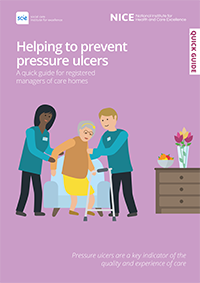A quick guide for registered managers of care homes
Pressure ulcers can be serious and lead to life-threatening complications, such as blood poisoning and gangrene.
However, taking some simple steps can reduce the chance of pressure ulcers developing.
Pressure ulcers are a key indicator of the quality and experience of care.
Who is most likely to get a pressure ulcer?
Anyone living in a care home can develop a pressure ulcer, but some factors make it more likely.
Risk factors include:
- Limited mobility or being unable to change position without help.
- A loss of feeling in part of the body.
- Having had a pressure ulcer before, or having one now.
- Not having eaten well for a period of time.
- Thin, dry or weak skin.
- A significant cognitive impairment.
How does a pressure ulcer occur?
A pressure ulcer happens when an area of skin and the tissues underneath it are damaged by being under such pressure that the blood supply is reduced. They tend to occur when people spend long periods in a bed or chair.
Risk assessment
A trained healthcare professional should carry out and document a pressure ulcer risk assessment within 6 hours for anyone who moves into a care home with nursing.
For people living in care homes who have one or more risk factors and who have been referred to the community nurse, a pressure ulcer risk assessment should be carried out and documented on their first visit.

A healthcare professional should reassess a person's pressure ulcer risk:
- after surgery or other investigation
- if they move to a different care setting
- if their underlying condition worsens
- after a change in their mobility.
If the person has several risk factors or a history of pressure ulcers, they should be assessed as being at high risk of developing a pressure ulcer. A trained healthcare professional should complete a skin assessment for anyone assessed as high risk.
Care planning
Make a written care plan for anyone assessed as being at high risk of developing a pressure ulcer and review it regularly. The plan should focus on the actions needed to help prevent a pressure ulcer from developing, taking into account:
- The results of the risk and skin assessment.
- The need for any extra pressure relief, for example a high-specification foam mattress or cushion.
- The person’s mobility and ability to change position unaided.
- Any other conditions.
- The person’s own views and wishes, including whether they are able to understand the risks and make an informed decision. If not, use of the Mental Capacity Act may be necessary.
Repositioning advice
Changing position to reduce or remove the pressure on a particular area can be key to preventing pressure ulcers.
Explain to anyone who has been assessed as being at risk of pressure ulcers:
- The importance of changing their position regularly and how it can help.
- How frequently to move, depending on the level of risk.
Repositioning help
Difficulty mobilising and a loss of feeling in part of the body are risk factors for developing pressure ulcers, and may make it difficult or impossible for the person to change position unaided.
If a person has been assessed as being at risk of developing pressure ulcers and cannot change position, give them the help they need to do so. Document how often the person needs to change position, and use equipment to help them if needed.
How often?
Repositioning is recommended every 6 hours for people at risk of developing pressure ulcers and every 4 hours for people at high risk.
How often it will happen should be agreed with the person, taking their needs and wishes into account.

Providing information
Anyone who is assessed as being at high risk of developing pressure ulcers should be given information on how to prevent them by a healthcare professional.
The information should be given in a way that the person can understand and should cover:
- What causes pressure ulcers.
- Early signs to look out for.
- How to prevent them.
- The effect of having a pressure ulcer on the person's health.
- How to use any equipment needed to change position.
Useful links
More information about pressure ulcers and resources to support prevention and management, including a skin inspection guide, can be found at Stop the Pressure - national wound care strategy programme.
- Pressure ulcers: prevention and management (NICE guideline)
- Pressure ulcers (NICE quality standard)
- Decision-making and mental capacity (NICE guideline)
- Safeguarding adults protocol: pressure ulcers and the interface with a safeguarding enquiry (Department of Health and Social Care)

Download this guide
We've created a copy of this guide that you can print and share:
This content has been co-produced by NICE and SCIE and is based on NICE's guideline and quality standard on pressure ulcers.